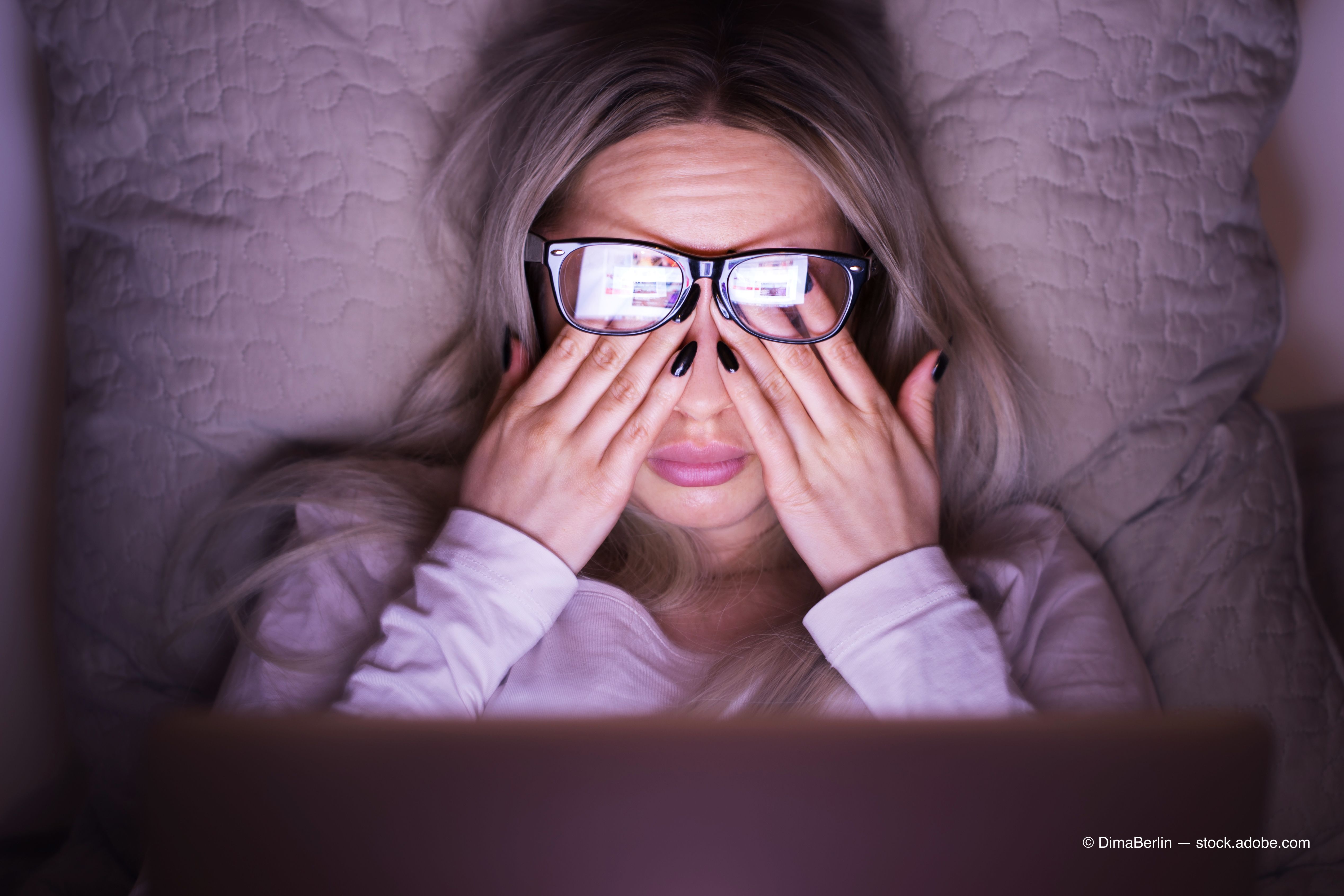Explore the relationship between dry eye and sleep


In the April 2017 issue (“How sleep affects the ocular surface”) I explored the relationship between sleep and dry eye/ocular surface dease. Since then, interest in this association has prompted additional research.
At every age each person needs adequate, uninterrupted sleep for optimal wakeful functioning.
Insufficient sleep is associated with a number of chronic diseases and conditions, such as diabetes, cardiovascular disease, obesity, and depression.1 Similarly, traditional medicine considers appropriate sleep, among other factors, essential to maintain ocular health.2
Related: How sleep apnea affects the eye
Compromised sleep
Data now suggests that suggests sleep quality may play an important role in the development of dry eye disease (DED) by influencing tear secretion and tear film stability and/or by indirectly aggravating anxiety and depression, leading to higher self-reported symptom scores.
In a recent murine model, sleep deprivation was demonstrated to induce dry eye through abnormal superficial corneal epithelial cell microvilli morphology.3,4
In another sleep deprivation mouse model, researchers found that sleep deficiency resulted in decreased aqueous tear secretion, increased corneal epithelial cell defects, increased corneal sensitivity and apoptosis; and induced squamous metaplasia of the corneal epithelium.5
Sleep quality
A systematic review and meta-analysis of sleep outcomes associated with found that DED patients may have poorer sleep quality; greater daytime sleepiness; less sleep; more sleep disturbances; and an increased prevalence, incidence, and severity of sleep disorders compared to non-DED patients.6
Patients may also suffer from a number of sleep disorders, including:
• Dyssomnias (insomnia, hypersomnia, sleep apnea)
• Parasomnias (disorders characterized by abnormal or unusual behavior of the nervous system during sleep, such as sleepwalking and [rapid eye movement] REM behavior disorder)
• Sleep bruxism (nocturnal tooth grinding may be associated disturbed sleep)
• Circadian rhythm sleep disorders
Related: Blog: Modern-day techniques for diagnosing dry eye disease
A 2009 Centers for Disease Control and Prevention (CDC) survey disclosed that adults who reported sleeping less than the recommended seven to nine hours per night were more likely to have difficulty performing daily tasks.7
CDC surveillance of sleep-related behaviors has increased in recent years and recognizes insufficient/poor sleep as a public health problem.
About 70 million Americans suffer from chronic sleep problems. Sleep problems are major contributors to chronic conditions like obesity and depression but are rarely addressed.8
The CDC’s Sleep and Sleep Disorders Team works to increase awareness of sleep health and sleep disorders and their impact on the public’s health. The team has developed and implemented new sleep questions for CDC’s public health surveillance systems, including the Behavioral Risk Factor Surveillance System, the world’s largest, ongoing telephone health survey system that has tracked health conditions and risk behaviors in the United States annually since 1984.9Related: Sleep apnea: More than a snore and floppy eyelids
The National Sleep Foundation offers suggestions to enhance patients’ sleep patterns-that is, sleep hygiene or the promotion of regular, healthy sleep habits.8
This begs the question: Should ODs incorporate a validated sleep survey into dry eye exams?
Akin to DED, numerous validated global and targeted patient sleep/sleepiness/insomnia questionnaires are available.10 Questionnaires can be selected to tease out sleep disorders in subsets of patients, for example, such as pediatric, adolescent, and adults, or obstructive sleep apnea suspects.
With novel technologies and emerging discovery, ODs’ evaluation of the ocular surface disease (OSD) patient has become more sophisticated and fine-tuned. Each snippet of information supplements the profile of individual dry eye patients and adds a target for therapeutic intervention.
Should ODs be prescribing lid hygiene and sleep hygiene?
Patient sleep survey results may add the extra clinical sign/symptom that may be the “tipping point” OSD patients-the management of which should be addressed.
Read more dry eye articles here
References:
1. Centers for Disease Control and Prevention. Sleep and Sleep Disorders. Available at: https://www.cdc.gov/sleep/index.html. Accessed 5/29/19.
2. Haji-Ali-Nili N, Khoshzaban F, Karimi M. Lifestyle determinants on prevention and improvement of dry eye disease from the perspective of Iranian traditional medicine. Iran J Med Sci. 2016 May;41(3 Suppl):S39.
3. Tang L, Wang X, Wu J, Li SM, Zhang Z, Wu S, Su T, Lin Z, Chen X, Liao X, Bai T, Qui Y, Reinach PS, Li W, Chen Y, Liu Z. Sleep deprivation induces dry eye through inhibition of PPARα expression in corneal epithelium. Invest Ophthalmol Vis Sci. 2018 Nov 1;59(13):5494-5508.
4. Karaca I, Yagci A, Palamar M, Tasbakan MS, Basoglu OK. Ocualr surface assessment and morphological alterations in Meibomian glands with meibography in obstructive sleep apnea Syndrome. Ocul Surf. 2019 Jun 18. pii: S1542-0124(19)30061-8. doi: 10.1016/j.jtos.2019.06.003.
5. Au NH, Mather R, To A, Malvankar-Mehta MS. Sleep outcomes associated with dry eye disease: a systematic review and meta-analysis. Can J Ophthalmol. 2019 Apr;54(2):180-189. doi: 10.1016/j.jcjo.2018.03.013.
6. Li S, Ning K, Zhou J, Guo Y, Zhang H, Zhu Y, Zhang L, Jia C, Chen Y, Sol Reinach P, Liu Z, Li W. Sleep deprivation disrupts the lacrimal system and induces dry eye disease. Exp Mol Med. 2018 Mar 2;50(3):e451.
7. Centers for Disease Control and Prevention. Morbidity and Mortality Weekly Report: March 4, 2011. Available at: https://www.cdc.gov/mmwr/PDF/wk/mm6008.pdf. Accessed 5/29/19.
8. National Sleep Foundation. Healthy Sleep Tips. Available at: https://sleepfoundation.org/excessivesleepiness/sleep-tools-tips/healthy-sleep-tips. Accessed 5/29/2019.
9. Centers for Disease Control and Prevention. Sleep and Sleep Disorders: About our program. Available at: https://www.cdc.gov/sleep/about_us.html. Accessed 5/29/19.
10. Lomeli HA, Perez-Olmos I, Talero-Gutierrez C, Moreno CB, Gonzalez-Reyes R, Palacios L, de la Pena F, Munoz-Delgado J. Sleep evaluation scales and questionaries: a review. Actas Esp Psiquiatr. 2008 Jan-Feb;36(1):50-9.

Newsletter
Want more insights like this? Subscribe to Optometry Times and get clinical pearls and practice tips delivered straight to your inbox.